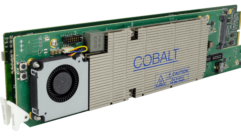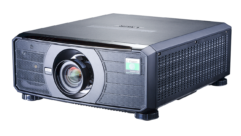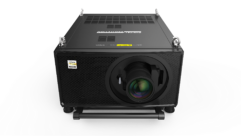Digital Projection Ups Ante with New 3-Chip Titan
Digital Projection International (DPI) announced what it calls a complete reinterpretation of the advanced three-chip display with its new Titan Quad product line.
Digital Projection Titan Quad
Digital Projection International (DPI) announced what it calls a complete reinterpretation of the advanced three-chip display with its new Titan Quad product line. Compact considering its lumen performance, the Titan Quad platform incorporates DPI’s active 3D connectivity, image warp and blend capabilities, a variety of native resolutions, and a list of professional features to suit almost any commercial or staging application, according to the company. DPI officials claim the Titan Quad family represents the first projectors of their brightness to be delivered in such a small chassis.
DPI said the Titan Quad is now the flagship of the Titan line and includes DPI’s exclusive ColorMax, FastFrame and, Dual Flash technologies. Utilizing DPI’s new, advanced electronics, all Titan Quad models provide the user with the ability to make geometric warp correction by adjusting an interpolated grid array of up to 16×16 nodes. Up to eight maps can be generated, downloaded, and stored within the projector’s electronics. Also standard on Titan Quad projectors: on-board adjustment for pincushion, barrel, cornerstone, vertical and horizontal keystone, and image rotation.
Edge blending and multiprojector tiling are accomplished via high-bit depth processing, according to the company. Black-level uplift in all non-blend areas guarantees uniformity across the screen, even when dark image content is displayed. End users can choose to utilize the Titan Quad’s on-board tiling function by assigning each projector a position within an image matrix. The video processing then automatically extracts the appropriate segment of the input image and enables blending for the appropriate edges, DPI said.
When it comes to 3D display, DPI’s Dual-Flash Processing allows 60Hz 3D sources to be frame-doubled and displayed at 120Hz on screen, or 24Hz 3D sources to be frame-tripled and displayed at 144 Hz. Dual-Pipe Connectivity allows the delivery of two sources in parallel, typically one for the left eye and one for the right. Digital Projection’s dual DVI input also enables the direct display of sequential sources at frame rates up to 144 frames per second, according to the company. Moreover, FastFrame motion blur reduction reduces motion artifacts associated with rapidly moving content, such as with sporting events, video games, or jet simulations.
With a light output of 16,000 lumens, the new Titan Quad projectors employ four 400W high-intensity discharge lamps to produce bright imagery, making them suitable for medium and large-venue applications. A range of lens shift allows for extensive installation flexibility, further augmented by an array of fixed and zoom lenses with throw ratios ranging from .67:1 to 11.2:1.










